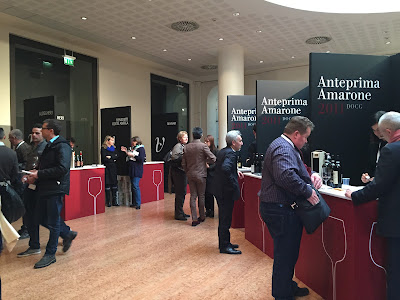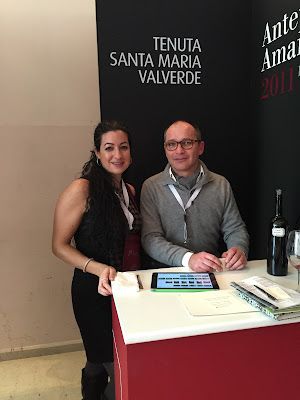 |
| Christian Marchesini (left), President of the Consorzio della Valpolicella |
Due to the 30 inch storm we got in Boston I got forced to head over to Italy a day early. Life is tough, but sometimes you gotta do it. Immediately that night I attended the Bolla winery and had a wine dinner with the winemaker and Director. The following days as you'll see I had a jam packed itinerary and attended a number of wineries throughout the Valpolicella wine region including luncheons at some of the wineries, or as they like to say “light lunches”, concluding the day with wine dinners.
After coming out of this crazy winter that we experienced I figured everyone has cabin fever and if you haven't been able to travel somewhere yet let's escape and what better place than to Italy. So join me virtually on my recent trip to the wonderful city of Verona in the Veneto region of northeastern Italy. I was invited by the Consortium of Valpolicella to explore the wine region and furthermore the Anteprima Amarone event, which was the release of the 2011 vintage of Amarone. I have lots more to share on my site Vino Travels where you can get a day by day glimpse into my wine journey, but I'll give you an overall idea of this region and what it has to offer from a vino point of view.
I was situated in the city of Verona and if you have never been it's well worth the visit. Verona itself has lots to offer especially in the nicer weather if you are a lover of arts where you can see musical performances in the historic Arena, similar to the Colosseum, as well as the ancient ruins of the Teatro Romano along the Adige River. It's great for shopping as well! Verona is a great place to base yourself whether it's by car or train and visiting towns like Vicenza, Padua and Venice in the Veneto or even other regions like Trentino and Emilia Romagna that are only about an hour away. Of course I was there for the food and wine and like any region in Italy has perfect pairings and traditions that I'd like to share.
To talk a little about the Valpolicella region to begin with for those that are unfamiliar with the wines, it's a land of hills and plains divided by 5 valleys with the Valpantena valley being considered the “cru” of the valleys for wine production. The indigenous grapes of this land that make up the Valpolicella and Amarone wines are corvina, corvinone, rondinella and molinara with molinara almost non-existent in some wines or is being used less and less. The regulations of this region are somewhat lax in regards to the varying percentages of each grape that are allowed to be used therefore the wines can be very different on a producer by producer basis.
The main wines of this region for reds include Valpolicella, which is more your everyday wine, Valpolicella Superiore, which is a year of aging and 1% more alcohol, Valpolicella Ripasso, which is a wine whose grape must is run or “repassed”, appassimento, over the leftover pressed skins of Amarone adding more complexity and body to the ripasso wine. Lastly, you have the prized wine of the region, Amarone, which goes through a special process where the grapes are picked and dried out for about 100-120 days on crates in well ventilated rooms within the region before they are pressed resulting in a wine of depth, concentration and richness. Amarone also comes at a higher price tag due to its status and quality.
The Anteprima Amarone event I attended took place at the Gran Guardia in the center of Verona in Piazza Bra on January 31st and February 1st. The event presented 64 producers from the Consorzio that released their 2011 Amarone vintage for tasting, which will be a vintage to experience in upcoming years. The wines from the event seemed to have the ability to age and develop in years to come. The wines were fresh, backed with lots of fruit that seemed complex with high alcohol and acidity that will start to smooth out in the next 2-3+ years. Many of the winemakers brought with them not only the 2011 bottles, but an older vintage as well to demonstrate how their wine ages over time.
 |
| Marco Speri |
At the event I also attended a blind tasting conducted by the engaging and enthusiastic hailing from Tuscany the top sommelier of Italy, Luca Martini. Seventeen wines were shared from one of the best vintages, 1998, as well as the 2003 and 2006 vintages. Tasting through the 1998 vintages showed the aging potential of these wines as many of the wines seemed younger than a wine that already had 17 years of age.

Olga Bussinello, Director of the Consorzio, with Luca Martini
The President of the Consortium, Christian Marchesini, shared that “Amarone is the engine of the economy” and with 80% of the wine being exported and the US importing 42% it's important to the brand of Amarone that the quality is maintained and continuously looked after to be improved to
protect it. As Luca Martini stated “the bottle and wine have a cultural heritage” and the best way to experience that first hand is to always bring yourself to the source, but it's not always that easy of an option for everybody so support your local shops and restaurants and seek these wines out for yourself to get a taste of the Veneto and the wines of Valpolicella.




No comments:
Post a Comment